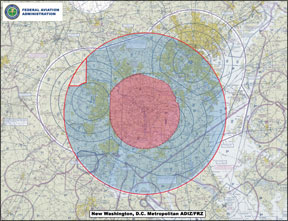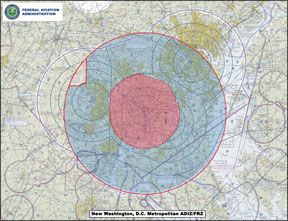Some airspace designs are badly done. Some have “badness” thrust upon them. The Washington Air Defense Identification Zone (ADIZ), cobbled together by Notam in early 2003 as a “temporary” measure in preparation for the invasion of Iraq, managed to incorporate both extremes. Along with a “zero-tolerance” approach to even the most cursory and innocent violation, the Washington ADIZ became an 288 operational burden, cartographic nightmare and growth industry for enforcement, all at the same time. With its TBO long past, FAA Administrator Marion Blakey at EAA AirVenture Oshkosh this July finally announced the ADIZ would receive a major overhaul as of August 30, 2007. (In an unrelated announcement, Blakey also said she will step down from her post as of September 13, her fifth anniversary on the job.) The associated Flight Restricted Zone (FRZ), or “freeze,” also will change, although its redesign will be much less substantive. On balance, the changes reduce the ADIZs size, releasing some operators and several airports from its requirements. At a handful of other airports, the new configuration simplifies ingress and egress; at many others, there is little new. In fact, for most operators using popular D.C.-area airports, nothing will change. Regardless, lets take a closer look at the changes, courtesy of an advisory publication from the FAA and available at 
Highlights
As weve noted, the first major change to the ADIZ is a reduction in size. Instead of overlying the Washington Tri-Area Class B Airspace Area and with one exception, the new ADIZ encompasses the airspace within a 30 nm radius of the Washington VOR/DME (DCA), located on the field at the Ronald Reagan Washington National Airport. It extends from the surface to but not including FL180. The chart excerpt below depicts the old and new ADIZ configurations. Additional configuration details are presented by the chart excerpts on page 22.
The exception involves the Leesburg Maneuvering Area, a notch cut out from the circular ADIZ for the Leesburg (Va.) Executive Airport (JYO). Without the cutout, JYO would be ever so slightly inside the new ADIZ; with it, VFR operations at JYO may be conducted without communicating with ATC, although an ADIZ flight plan must be filed and radio calls on the published CTAF frequency must be made.
Interestingly, the published advisory notes pilots must activate and close their ADIZ flight plan by announcing the aircraft call sign, aircraft type and runway to be used on the CTAF. This implies someone other than fellow pilots will be listening to the CTAF. For more details on the Leesburg Maneuvering Area, refer to the sidebar at right.
Another highlight involves speed limits. Earlier iterations of the ADIZ did not include a limit on indicated airspeed. With the new ADIZ, two speed limits are imposed on VFR aircraft. The first, 180 KIAS, applies within the ADIZ itself. The second is referred to as the “Outer Speed Restriction” in the FAAs published advisory and is 230 KIAS. It applies in the area defined as between 30 and 60 nm radius from the DCA VOR/DME. In both cases, the speed limit applies only to VFR operations and operators are expected to advise ATC
prior to entering an area where a speed limit applies if theyre unable to comply.Details
Those are the highlights of the new ADIZ configuration and procedures. The details are similar-sometimes identical-to earlier ADIZ versions.
The first, biggest one is the ADIZs new dimensions. As noted, the previous configuration was based on the areas Class B airspace, itself comprised of three intersecting circles drawn around the three major airports: DCA, Washington Dulles International Airport and the Baltimore/Washington International Thurgood Marshal Airport. The three circles intersected in such a way many were reminded of a certain cartoon character, giving rise to the derisive “Mickey Mouse ADIZ” monicker.
More important, however, is that four public-use general aviation airports and 1800 square miles of airspace, according to AOPA, are no longer in the ADIZ.
Within the new ADIZ, the old rules apply. These include:
The aircraft must be equipped with an operable two-way radio and a transponder with automatic altitude reporting capability (Mode C).
Operators must file and activate an IFR DC ADIZ flight plan for VFR (ADIZ flight plan).
Aircraft must monitor VHF guard, 121.5 MHz, if able.
Before departing from an airport within the ADIZ or before entering the ADIZ, pilots must obtain a discrete transponder code from ATC and must continuously squawk that code until leaving the ADIZ or landing at an airport within it.
Pilots may not squawk 1200 at any time while in the ADIZ.
Two-way radio communication with the appropriate ATC facility is required before entering and while operating in the ADIZ, except when specified (e.g., when using the CTAF at a non-towered facility).
As always, pilots must obtain an appropriate clearance before operating within Class B airspace and must establish two-way communications with the ATC facility providing air traffic services before entering Class D airspace.
Tips And Tricks
Despite its reduced size and the handful of airports no longer within the ADIZ, the basics of operating there havent really changed: For most operations, you still must file a flight plan, obtain a discrete squawk code and talk to ATC. But there are some tricks you can employ to make all of this less burdensome and more transparent.
The first and most obvious “trick” is to file and fly IFR if capable. Since the ADIZ VFR flight plan is basically an IFR flight plan without requiring the pilot to be Instrument-rated and the aircraft appropriately equipped, going IFR makes all of this pretty seamless. In fact, ATC treats IFR operations in the ADIZ the same as they do anywhere else.
Meanwhile, VFR pilots should not get caught up in worrying about opening and closing their ADIZ flight plans as they might when filing a VFR flight plan. Since an ADIZ flight plan is treated as IFR, they are opened and closed for you when initially contacting ATC and when departing the ADIZ or landing at your destination within the ADIZ, as appropriate.
Another tip for VFR operations into the ADIZ concerns when to contact ATC requesting entry: Dont go steaming up to the boundary, call the Potomac Tracon and expect to be greeted with open arms, and allowed to go on your merry way without delay. It can happen, but you shouldnt count on it. The issue is that the controller has some paperwork and button-pushing to do, verifying your ADIZ flight plan is available and coming up with the discrete squawk code you need. All that can take time.
Instead, its best to get into the system as early as possible. Since the Potomac Tracon is responsible for a huge slice of airspace-extending from south of Richmond, Va., to north of Baltimore, its a relatively trivial task to ask for and obtain VFR flight following well before getting too close to the ADIZ. Its also helpful to ensure the Potomac controller is fully aware you plan to enter the ADIZ so he or she can check to ensure your ADIZ flight plan is on file, and coordinate with the sector youll be in when approaching the ADIZ boundary.
Finally, never squawk 1200 inside the ADIZ; in fact, dont be too quick to squawk VFR upon leaving the ADIZ either. Numerous enforcement actions have been brought over the years against pilots too anxious to go “1200.” Also, certain transponders-those with a dedicated VFR button-can be problematic in the ADIZ, earning their pilots a trip through the enforcement maze. Just leave that button alone or use the manufacturers literature to read up on disabling it.
Training Resources
It is strongly recommended that all pilots flying VFR within 100 nm of the DCA VOR/DME complete special awareness training for the Washington D.C. Metropolitan Area. That free training is available online at the FAAs Aviation Learning Center,
http://www.faasafety.gov/.Additionally, the AOPA Air Safety Foundation (ASF) has two free online programs pilots unfamiliar with the ADIZ will find useful. The first is a course entitled
Know Before You Go: Navigating Todays Airspace, which is available at http://www.aopa.org/asf/online_courses/know_before/. Satisfactory completion of this course fulfills the safety seminar requirement for the FAAs Wings Program.The AOPA ASFs other online program is a four-minute presentation covering the Visual Warning System, a laser-based affair located at different sites within the ADIZ designed to get the attention of pilots who may have stumbled into the Washington area and who arent on an appropriate communications frequency. This presentation is available at
http://www.aopa.org/safetycenter/courses/vws/.Other Stuff
Some other “features” of the ADIZ have changed along with its size and shape; some havent. For example, closed-pattern work at airports within the ADIZ continues to be allowed-it wasnt at first; you were either entering or departing the ADIZ. Slightly different procedures exist, one set for a towered airport and one set for non-towered.
Also, operators departing six smaller airports within the ADIZ can squawk 1205 and are not required to file a flight plan or talk to ATC. On entering the ADIZ, however, normal procedures apply.
Finally, the special procedures applying to other airports on the border of the “old” ADIZ will no longer be in effect when the new configuration becomes operative.
On the whole, the Washington ADIZ just needs to go away. It really exists only as a bureaucratic crutch, and to help perpetuate the government-sponsored fear heaped upon the citizens over the last six years. Anyone determined to use an airplane as a guided missile can figure out an easy way around these restrictions.
Still, these changes are seemingly better thought-out than the initial ADIZ requirements and for that we all can be thankful. Lets hope the new ADIZ marks the beginning of a trend back toward normalcy.




